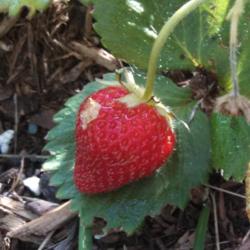
Strawberries are in full production in their second year. The first year, you buy plants - usually in bunches of 25 or 50. (For large quantities or special varieties, order from a mail-order nursery.) These plants are sometimes called mother plants because 5 or 6 weeks after planting they will start sending out runners, a few or many, depending on the variety. When a runner reaches 8 to 10 inches in length, it will bend upward and begin to form a new daughter plant; the runner will continue outward and set several more daughter plants. The daughters provide most of the crop the following year.
How Many Plants?How many plants you'll need depends on how many strawberries you want. As a rule of thumb, buy one plant for every 1 or 2 quarts of berries you'd like to harvest. Of course, this formula assumes you'll be taking good care of every plant. If you start with 10 plants the first year - and they each produce five healthy daughter plants - you'll get from 50 to 100 quarts of berries. Selecting the right type of strawberry requires a little research. You can buy varieties that are resistant to diseases such as red stele or verticillium wilt, and different varieties are suited to different parts of the country.
Everbearing VarietiesEverbearing varieties yield a light crop in early summer, a few berries during the summer, and then another heavier crop in late summer or fall. "Day-neutral" varieties bear all season, but this term is often used interchangeably with everbearers. To be really technical, day-neutrals are sometimes everbearing, usually on the West Coast, but the reverse is never true.) Regular spring- or June-bearing varieties yield more than everbearers, but over a shorter season. Everbearers often fare poorly in the southern and northern extremes of the country; they are best suited to the middle regions, zones 5 to 8.
Digging PlantsWhatever variety you choose, try to buy new plants from a commercial grower. Digging your own daughter plants from an old bed leads to diseased, weakened, unproductive plants that aren't worth the money saved. When ordering from a commercial grower, specify fall-dug plants (commercial suppliers are able to store them well over the winter). These may look scrawny and pathetic after winter storage, but they will rapidly overtake the more attractive spring-dug plants. If you do use spring-dug plants, however, they will suffer some root loss, so you should remove about half the leaves to balance the tops with the reduced root systems - and keep them moist while they await planting.
 Victory Seed Company has all the seeds you want for your best garden in 2024.
Victory Seed Company has all the seeds you want for your best garden in 2024.
For 25 years, the family-owned Victory Seed Company has provided the highest quality vegetable, herb and flower seeds to families across the country. We are passionate about providing you the best seeds available that give excellent germination, robust plants, and the harvest you want. With a catalog of over a thousand varieties, we have everything, and our prices are the kinds that we'd want to pay. We have hundreds of yesterday's heirloom vegetables, as well as today's award winning hybrid selections. Get to know us by visiting our website and browsing through our online vegetable seed catalog.
| 1. Strawberry Essentials |
| 2. Getting Ready for Strawberries |
| 3. Buying Strawberry Plants ← you're on this article right now |
| 4. Planting Strawberries |
| 5. Care and Harvest of Strawberries |
| 1. Strawberry Essentials |
| 2. Getting Ready for Strawberries |
| 3. Buying Strawberry Plants ← you're on this article right now |
| 4. Planting Strawberries |
| 5. Care and Harvest of Strawberries |